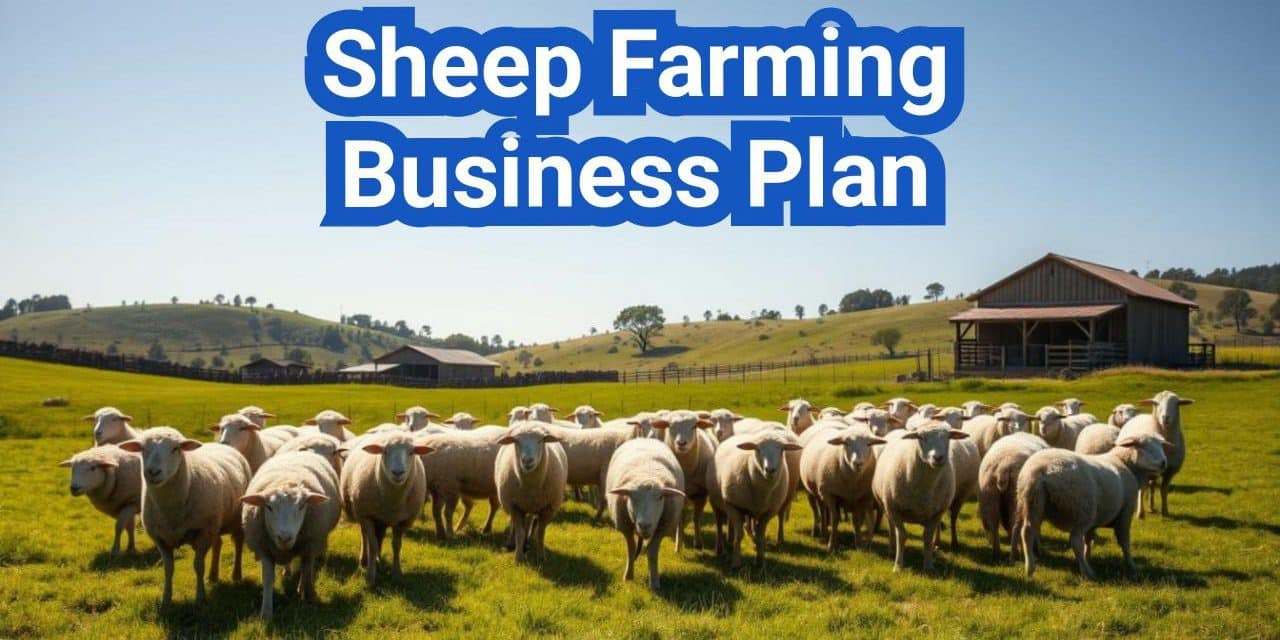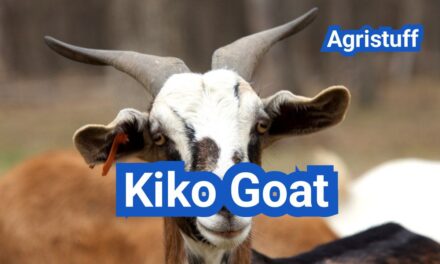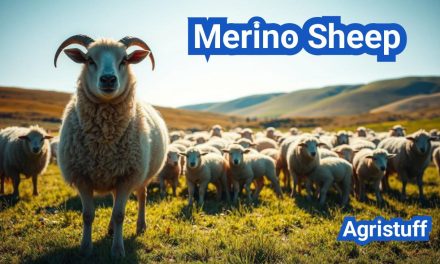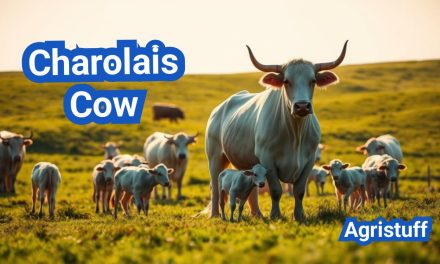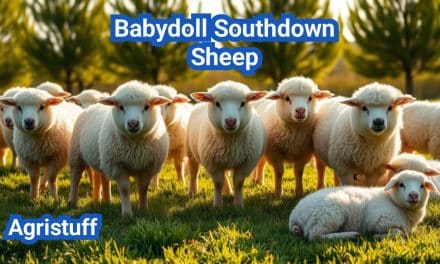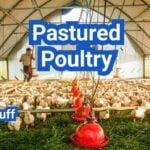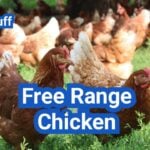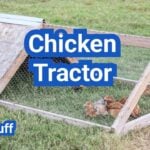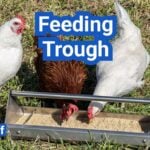Creating a comprehensive Sheep Farming business plan is crucial for the success of any sheep farming operation. It serves as a roadmap, guiding you through the initial investment and helping you achieve long-term profitability.
A well-structured business plan template can help you outline your goals, understand the startup costs, and develop a viable business model. This, in turn, enables you to make informed decisions and navigate the challenges of sheep farming.
Understanding the costs and potential profits is essential for any aspiring sheep farmer. By developing a robust business plan, you can ensure the financial viability of your operation and achieve success in the competitive world of sheep farming.
Key Takeaways
- Develop a comprehensive business plan to guide your sheep farming operation.
- Understand the startup costs and potential profits to ensure financial viability.
- Create a viable business model to achieve long-term success.
- Use a business plan template to outline your goals and objectives.
- Make informed decisions by understanding the costs and potential profits.
Understanding the Sheep Farming Industry
Understanding the dynamics of the sheep farming industry is crucial for developing a successful business plan. The industry is subject to various market trends, including fluctuations in demand and supply, which can significantly impact profitability.
Current Market Trends in Sheep Farming
The sheep farming industry is influenced by several market trends. Increasing demand for lamb and lamb products is driving growth in the industry. Additionally, there is a growing interest in sustainable and environmentally friendly farming practices, such as rotational grazing, which can enhance the overall profitability of sheep farming operations.
Market trends also indicate a shift towards grass-fed lamb production, with consumers willing to pay a premium for products perceived as more natural or organic. This trend presents opportunities for sheep farmers to differentiate their products and command higher prices.
| Market Trend | Impact on Sheep Farming |
|---|---|
| Increasing demand for lamb | Potential for higher prices and increased revenue |
| Growing interest in sustainable practices | Opportunities for farmers to adopt rotational grazing and other environmentally friendly methods |
| Shift towards grass-fed lamb production | Potential for premium pricing and market differentiation |
Opportunities and Challenges in the US Sheep Industry
The US sheep industry faces several challenges, including competition from imported lamb products and fluctuations in feed costs. However, there are also opportunities for growth, particularly in niche markets such as direct-to-consumer sales and value-added products.
To succeed, sheep farmers must be aware of these trends and challenges and adapt their business strategies accordingly. This may involve diversifying their operations, investing in marketing, or exploring new revenue streams.
Benefits of Creating a Sheep Farming Business Plan

The process of crafting a sheep farming business plan helps farmers clarify their vision, identify potential pitfalls, and make informed decisions. This foundational document is crucial for guiding the overall strategy and direction of the farm.
Setting Clear Goals and Objectives Of Sheep Farming Business Plan
A well-structured business plan enables sheep farmers to set clear, achievable goals. By defining specific objectives, farmers can better allocate resources, prioritize tasks, and measure progress over time.
For instance, a farmer might set a goal to increase lamb production by 20% within the next two years. This objective would then guide decisions on breeding stock, feed management, and marketing strategies.
Securing Funding and Investment Of Sheep Farming Business Plan
One of the significant benefits of a sheep farming business plan is its role in securing funding and investment. Investors and lenders often require a detailed business plan to assess the viability and potential return on investment of a farming operation.
“A business plan is a farm’s calling card to the financial world. It demonstrates the farmer’s professionalism and commitment to success.”
A comprehensive plan includes financial projections, market analysis, and operational strategies, all of which are critical for convincing investors of the farm’s potential.
| Financial Component | Description | Importance |
|---|---|---|
| Startup Costs | Initial investment for land, equipment, and livestock | High |
| Operational Expenses | Ongoing costs for feed, veterinary care, and labor | High |
| Revenue Projections | Projected income from lamb sales, wool, and other products | High |
Planning for Long-term Success Of Sheep Farming Business Plan
Long-term success in sheep farming requires careful planning and adaptation to changing market conditions and environmental factors. A business plan helps farmers anticipate challenges and develop strategies to mitigate risks.
By regularly reviewing and updating their business plan, sheep farmers can ensure they remain on track to meet their goals and adjust to new opportunities or challenges as they arise.
Essential Components of a Sheep Farming Business Plan
To establish a thriving sheep farming business, it’s essential to create a detailed business plan. A comprehensive business plan includes several key elements that help guide your decision-making and ensure the long-term success of your operation.
Executive Summary Of Sheep Farming Business Plan
The executive summary is a concise overview of your sheep farming business, highlighting its main objectives, products, and strategies. It should provide a clear and compelling summary of your business plan, enticing readers to learn more about your operation.
A well-crafted executive summary should include:
- A brief description of your business and its mission
- An overview of your products and services
- A summary of your market analysis and competitive landscape
- An outline of your financial projections and funding requirements
Mission and Vision Statements Of Sheep Farming Business Plan
Your mission and vision statements are crucial components of your business plan, as they define the purpose and direction of your sheep farming operation. Your mission statement should clearly articulate your business’s goals and values, while your vision statement should outline your long-term aspirations.
“Our mission is to provide high-quality sheep products while maintaining a sustainable and environmentally friendly farming practice.” – Example Sheep Farm
Market Analysis Of Sheep Farming Business Plan
A thorough market analysis is vital for understanding the demand for your sheep products and identifying potential competitors. This analysis should include an examination of market trends, consumer preferences, and competitor activity.
| Market Segment | Demand | Competition |
|---|---|---|
| Meat Production | High | Moderate |
| Wool Production | Moderate | Low |
| Breeding Stock | Low | High |
Operational Strategy | Sheep Farming Business Plan
Your operational strategy outlines the day-to-day activities and decisions necessary to run your sheep farming business. This includes planning for land management, flock health, and nutrition, as well as managing labor and resources.
A well-planned operational strategy should consider:
- Grazing management and pasture rotation
- Flock health and veterinary care
- Nutrition and feeding strategies
- Labor management and training
By incorporating these essential components into your sheep farming business plan, you can create a comprehensive roadmap for success and ensure the long-term viability of your operation.
Analyzing Startup Costs for Sheep Farming

Before diving into sheep farming, it’s essential to understand the various startup costs involved. Starting a sheep farming business requires a significant initial investment, which can be a barrier for many potential farmers. The total startup costs will depend on several factors, including the size of the operation, land requirements, and the type of sheep being raised.
Land and Infrastructure Requirements | Sheep Farming Business Plan
The first major cost to consider is land and infrastructure. Sheep farming requires adequate pastureland for grazing, as well as facilities for housing and managing the flock. The cost of land can vary significantly depending on location, soil quality, and existing infrastructure. Farmers should also consider the cost of fencing, which is essential for managing grazing areas and protecting the flock from predators.
Infrastructure costs may include barn construction or renovation, equipment for feeding and watering, and facilities for shearing and handling sheep. The quality and durability of these infrastructure investments can impact long-term operational costs and efficiency.
Equipment and Supplies | Sheep Farming Business Plan
In addition to land and infrastructure, new sheep farmers will need to invest in essential equipment and supplies. This includes:
- Shearing equipment and tools
- Feeding and watering systems
- Fencing materials
- Handling equipment, such as chutes and scales
- Veterinary supplies
The quality and quantity of equipment needed can vary based on the size of the operation and the specific needs of the flock.
Initial Livestock Investment | Sheep Farming Business Plan
The initial livestock investment is typically one of the largest startup costs for sheep farming. The cost per animal can vary depending on the breed, age, and quality of the sheep. Farmers should research different breeds to determine which are best suited to their operation and market demands.
It’s crucial to consider not just the initial purchase price of the sheep but also the ongoing costs associated with their care, including feed, veterinary care, and other management expenses.
Start-up Cost Summary Template | Sheep Farming Business Plan
To help prospective sheep farmers plan their startup costs, creating a detailed summary is essential. A start-up cost summary template should include categories for land acquisition or lease, infrastructure development, equipment purchases, initial livestock purchase, and other initial expenses.
By carefully analyzing and planning for these startup costs, new sheep farmers can better position themselves for success in the industry.
Selecting the Right Sheep Breeds for Your Business Model
Understanding the characteristics of various sheep breeds is essential for determining the best fit for your operation. Different sheep breeds offer various advantages, making the selection process critical for your business model.
Meat Production Breeds | Sheep Farming Business Plan
For farmers focusing on meat production, certain sheep breeds are more suitable due to their growth rates, muscle development, and meat quality. Popular breeds include:
- Suffolk: Known for their rapid growth rate and high-quality meat.
- Dorset: Offers good meat production and is adaptable to various climates.
- Hampshire: Recognized for their fast growth and high meat yield.
Wool Production Breeds | Sheep Farming Business Plan
If your business model focuses on wool production, you’ll want breeds that produce high-quality fleece. Some of the top wool production breeds include:
- Merino: Renowned for their fine wool and high wool production.
- Rambouillet: Known for their large, soft wool fleeces.
- Corriedale: Offers a balance between wool production and meat quality.
Dual-Purpose Breeds | Sheep Farming Business Plan
For farmers who want to diversify their income streams, dual-purpose breeds can be an excellent choice. These breeds offer both good meat and wool production. Examples include:
- Columbia: Known for their hardiness and good production of both meat and wool.
- Targhee: Offers a good balance between meat and wool production.
Best Breeds for Beginners | Sheep Farming Business Plan
For those new to sheep farming, certain breeds are more beginner-friendly due to their hardiness and ease of management. Some recommended breeds include:
- Katahdin: Known for their parasite resistance and ease of handling.
- Dorset: Adaptable and relatively easy to manage.
When selecting a sheep breed, it’s crucial to consider factors such as climate, market demand, and your farm’s resources. Here’s a summary table to help compare some of the key characteristics of the mentioned breeds:
| Breed | Primary Use | Climate Adaptability | Growth Rate |
|---|---|---|---|
| Suffolk | Meat | Moderate | Fast |
| Merino | Wool | High | Moderate |
| Columbia | Dual-Purpose | High | Moderate |
| Katahdin | Meat | High | Moderate |
By carefully considering the characteristics of different sheep breeds and how they align with your business model, you can make an informed decision that enhances your farm’s productivity and profitability.
Developing a Sheep Farming Business Model

Sheep farming businesses can thrive by adopting a well-structured business model that aligns with their resources and market opportunities. The choice of business model significantly impacts the profitability and sustainability of the farm.
Commercial Lamb Production | Sheep Farming Business Plan
Commercial lamb production is a popular business model focused on raising lambs for meat. This model requires efficient feeding strategies, health management, and marketing to ensure profitability.
The advantages of commercial lamb production include a relatively quick turnaround and a well-established market demand. However, it also comes with challenges such as fluctuating feed prices and market competition.
Wool and Fiber Production | Sheep Farming Business Plan
Wool and fiber production is another viable business model, particularly for farms with breeds known for their high-quality wool. This model involves careful breeding, grazing management, and processing to produce valuable wool products.
The benefits of wool production include the potential for high-value products and diversification from meat production. Challenges include the need for specialized knowledge and equipment for processing wool.
Breeding Stock Sales | Sheep Farming Business Plan
Breeding stock sales involve raising high-quality sheep for sale to other farmers. This model requires a strong focus on genetics, breeding programs, and marketing to potential buyers.
Advantages include the potential for high returns per animal and the opportunity to build a reputation in the industry. Challenges include the need for significant upfront investment in quality breeding stock.
Agritourism Opportunities | Sheep Farming Business Plan
Agritourism is an emerging business model that involves opening the farm to visitors. This can include farm tours, sheep herding demonstrations, and other activities that educate and entertain visitors.
Agritourism can provide a significant additional income stream and help diversify the farm’s revenue. However, it requires investment in infrastructure and managing visitor experiences.
| Business Model | Key Focus | Potential Income |
|---|---|---|
| Commercial Lamb Production | Meat production, feeding strategies | High volume, moderate margin |
| Wool and Fiber Production | Breeding, grazing management, processing | High-value products, niche market |
| Breeding Stock Sales | Genetics, breeding programs, marketing | High returns per animal, reputation building |
| Agritourism | Farm tours, visitor experiences | Diversified income, educational opportunities |
Implementing Sustainable Grazing Systems
Sheep farmers are increasingly adopting sustainable grazing practices to enhance environmental stewardship and farm profitability. Sustainable grazing systems, such as rotational grazing, can significantly improve the productivity and sustainability of sheep farming operations.
Rotational Grazing Strategies | Sheep Farming Business Plan
Rotational grazing involves moving sheep to different areas of pasture to allow the vegetation in the previous area to recover. This strategy helps in maintaining pasture health, reducing erosion, and increasing the overall productivity of the land.
Benefits of Rotational Grazing:
- Improved pasture utilization
- Enhanced soil health
- Increased biodiversity
- Better parasite control
Sheep Grazing on Solar Farms | Sheep Farming Business Plan
An innovative approach to sustainable grazing is integrating sheep grazing with solar farms. This practice, known as agrivoltaics, allows for the co-location of solar panels and grazing operations, enhancing land use efficiency.
Agrivoltaics offers several benefits, including:
- Reduced vegetation management costs for solar farms
- Additional income streams for farmers
- Enhanced environmental benefits through dual land use
Pasture Management Techniques | Sheep Farming Business Plan
Effective pasture management is crucial for the success of sheep grazing operations. Techniques include monitoring pasture health, managing stocking rates, and implementing appropriate grazing strategies.
| Technique | Description | Benefits |
|---|---|---|
| Pasture Monitoring | Regular assessment of pasture condition | Early detection of issues, informed decision-making |
| Stocking Rate Management | Adjusting the number of sheep based on pasture availability | Prevents overgrazing, maintains pasture health |
| Grazing Strategies | Implementing rotational or strip grazing | Improves pasture utilization, reduces erosion |
Preparing Your Farm for Sheep | Sheep Farming Business Plan
Before introducing sheep to your farm, it’s essential to prepare the land and infrastructure. This includes fencing, providing adequate water supply, and ensuring the availability of appropriate shelter.
Key Considerations:
- Fencing that is secure and appropriate for sheep
- Adequate water supply and quality
- Shelter and protection from extreme weather
Intensive Sheep Farming Operations

Intensive sheep farming operations offer a viable option for farmers looking to increase their output and improve their bottom line. These operations involve a range of practices aimed at maximizing productivity and profitability.
Sheep Fattening Business Models
Sheep fattening is a crucial aspect of intensive sheep farming, focusing on optimizing the weight gain of sheep for meat production. This business model requires careful planning, including selecting the right breeds, nutrition management, and health care.
Key considerations for sheep fattening:
- Nutritional requirements for optimal weight gain
- Health management practices to prevent disease
- Breeding strategies to improve growth rates
Feedlot Operations | Sheep Farming Business Plan
Feedlot operations are another component of intensive sheep farming, where sheep are raised in a controlled environment to promote efficient growth. These operations require significant investment in infrastructure and management.
Benefits of feedlot operations include:
- Better control over nutrition and health
- Increased efficiency in resource use
- Potential for higher returns on investment
Intensive vs. Extensive Production Systems | Sheep Farming Business Plan
The choice between intensive and extensive production systems depends on various factors, including land availability, capital investment, and market demand. Intensive systems offer higher productivity per acre, while extensive systems may provide better animal welfare and environmental benefits.
“The future of sheep farming lies in balancing productivity with sustainability, whether through intensive or extensive systems.”
Space and Resource Requirements | Sheep Farming Business Plan
Intensive sheep farming operations have specific space and resource requirements, including adequate feed, water, and shelter. Planning for these requirements is crucial for the success of the operation.
Key resources to consider:
| Resource | Description | Importance |
|---|---|---|
| Feed | Nutritional input for growth and health | High |
| Water | Adequate hydration for sheep | High |
| Shelter | Protection from elements | Medium |
Creating a Sheep Farming Business Plan Template

Creating a sheep farming business plan template is a fundamental step in establishing a profitable sheep farming business. This template serves as a blueprint, outlining the necessary steps and strategies for achieving success in the competitive sheep farming industry.
Step-by-Step Business Plan Development | Sheep Farming Business Plan
Developing a business plan for your sheep farming operation involves several key steps. First, you need to define your business goals and objectives. This includes determining the scale of your operation, the resources required, and the potential market for your products.
- Conduct market research to understand the demand for sheep products.
- Outline your production costs, including land, equipment, and livestock.
- Develop a marketing strategy to reach potential customers.
According to agricultural experts, “A well-crafted business plan is essential for securing funding and making informed decisions about your sheep farming operation.”
“A good business plan is like a roadmap; it guides you through the ups and downs of your business journey.” –
Agricultural Finance Corporation
Sample Business Plan for Sheep Farming
A sample business plan for sheep farming can provide valuable insights into the structure and content of your own plan. Here’s an example of what a basic business plan might include:
| Business Component | Description | Example |
|---|---|---|
| Executive Summary | Overview of the business | Sheep farming operation focusing on wool production |
| Market Analysis | Analysis of market trends and demand | Growing demand for organic wool products |
| Operational Plan | Details on farming practices and management | Rotational grazing to maintain pasture health |
Customizing Your Plan for Different Business Models
Sheep farming businesses can vary significantly, from small-scale operations focusing on niche markets to large commercial enterprises. Customizing your business plan to fit your specific business model is crucial.
For instance, a business focusing on agritourism might include additional components related to customer experience and tourism infrastructure.
Online Business Plan Generators and Resources
For those who are new to business planning or need additional guidance, online business plan generators can be a valuable resource. These tools provide templates and step-by-step guidance to help you develop a comprehensive business plan.
Some popular online resources include business plan software and agricultural extension services that offer templates and consulting services tailored to the needs of sheep farmers.
Financial Projections and Budgeting

Financial projections and budgeting are essential components of a sheep farming business plan that help farmers make informed decisions. A comprehensive financial plan enables sheep farmers to anticipate expenses, predict revenue, and adjust their strategies accordingly.
Enterprise Budget for Sheep Farming | Sheep Farming Business Plan
An enterprise budget is a detailed financial plan that outlines projected income and expenses for a specific agricultural enterprise, such as sheep farming. It includes costs associated with land preparation, equipment, livestock, feed, veterinary care, and other operational expenses.
To create an effective enterprise budget, sheep farmers should consider the following elements:
- Initial start-up costs
- Ongoing operational expenses
- Projected revenue streams
- Potential risks and contingencies
Revenue Streams and Pricing Strategies | Sheep Farming Business Plan
Sheep farmers can generate revenue through various channels, including the sale of lambs, wool, and breeding stock. Developing effective pricing strategies is crucial to ensure profitability.
Some key considerations for revenue streams and pricing include:
- Market demand and competition
- Production costs
- Quality and uniqueness of products
- Target market segments
Break-Even Analysis | Sheep Farming Business Plan
A break-even analysis is a critical tool for sheep farmers to determine when their operation will become profitable. It involves calculating the point at which total revenue equals total fixed and variable costs.
To conduct a break-even analysis, farmers need to know their fixed costs, variable costs per unit, and the selling price per unit. The formula for break-even analysis is: Break-Even Point = Fixed Costs / (Selling Price per Unit – Variable Costs per Unit).
Sheep Operation Budget Template
Utilizing a sheep operation budget template can simplify the budgeting process. A typical template includes sections for income, expenses, and cash flow projections.
| Category | Description | Estimated Cost |
|---|---|---|
| Land Preparation | Costs associated with preparing land for grazing | $1,000 |
| Equipment | Fencing, watering systems, and other necessary equipment | $5,000 |
| Livestock | Initial purchase of sheep and ongoing replacement costs | $10,000 |
| Feed and Nutrition | Ongoing costs for feed and nutritional supplements | $3,000/year |
| Veterinary Care | Costs for vaccinations, health checks, and medical treatments | $1,500/year |
Marketing Strategies for Sheep Products

To succeed in the sheep farming business, farmers must develop and execute effective marketing plans. Effective marketing strategies are essential for sheep farmers to sell their products and build a loyal customer base.
Direct Market Lamb Sales
Direct market lamb sales offer sheep farmers an opportunity to sell their products directly to consumers, potentially increasing profit margins. This approach allows farmers to build a direct relationship with their customers, understand their preferences, and tailor their products accordingly.
- Identify local markets and festivals to showcase products
- Develop a strong online presence through social media and websites
- Offer farm tours to educate consumers about sheep farming practices
Grass-Fed Lamb Marketing in the USA
Grass-fed lamb marketing has gained popularity in the USA due to the increasing demand for organic and naturally raised livestock products. Sheep farmers can capitalize on this trend by highlighting the benefits of grass-fed lamb.
Key strategies include:
- Certification: Obtain relevant certifications such as “Certified Grassfed by the American Grassfed Association”
- Labeling: Use clear labeling that communicates the grass-fed nature of the product
- Storytelling: Share the story behind the farm and the farming practices
Building Your Brand and Customer Base
Building a strong brand and customer base is crucial for the long-term success of sheep farming operations. This involves creating a unique identity for the farm and its products.
Effective branding strategies include:
- Developing a unique logo and brand identity
- Engaging with customers through social media and email newsletters
- Participating in local agricultural events and conferences
Value-Added Products
Creating value-added products is a viable strategy for sheep farmers to differentiate their offerings and increase profitability. Examples include sheep’s milk products, wool crafts, and specialty meats.
Benefits of value-added products:
- Increased profit margins
- Diversification of product offerings
- Enhanced customer engagement through unique products
Managing Operational Costs in Sheep Farming
The profitability of sheep farming operations heavily depends on the ability to manage operational costs efficiently. Operational costs encompass various expenses, including feed and nutrition, healthcare and veterinary services, and labor and management. Effective management of these costs is crucial for maintaining profitability and ensuring the long-term sustainability of the farm.
Feed and Nutrition Costs
Feed and nutrition costs are typically one of the largest expenses in sheep farming. The cost of feeding your flock can vary significantly depending on factors such as the breed of sheep, their age, and the production system (intensive vs. extensive). Nutritional management plays a critical role in the health and productivity of the flock. Strategies to manage feed costs include optimizing grazing practices, using cost-effective feed supplements, and implementing efficient feeding systems.
Healthcare and Veterinary Expenses
Healthcare and veterinary expenses are another significant component of operational costs. Regular veterinary care, vaccinations, and parasite control measures are essential for maintaining the health of the flock. Preventive healthcare can reduce the incidence of disease and minimize the need for costly treatments. Farmers should work closely with their veterinarians to develop a healthcare plan that balances cost with the need for effective disease management.
Vaccination Schedule and Health Management
A well-planned vaccination schedule is a critical aspect of health management in sheep farming. The specific vaccines used and the frequency of vaccination will depend on factors such as the disease prevalence in the area, the age and health status of the flock, and the production system. Regular monitoring of flock health and prompt intervention when health issues arise are also crucial for preventing disease outbreaks and reducing the economic impact of illness.
Labor and Management Considerations
Labor and management are significant operational costs in sheep farming, particularly in larger or more intensive operations. Effective labor management involves ensuring that staff are well-trained, motivated, and utilized efficiently. Good management practices, including record-keeping, monitoring of flock health and performance, and timely decision-making, are essential for optimizing the productivity of the farm and controlling labor costs.
Analyzing Profitability in Sheep Farming

The financial success of sheep farming operations hinges on understanding and improving profitability. To achieve this, farmers must analyze various aspects of their business.
Key Profitability Metrics
Several key metrics are crucial for analyzing profitability in sheep farming. These include:
- Gross Margin: The difference between revenue and the variable costs associated with sheep production.
- Net Profit: The total revenue minus all costs, including fixed and variable expenses.
- Return on Investment (ROI): A measure of the return generated by the investment in the sheep farming operation.
Profit per Acre Calculations
Calculating profit per acre is vital for understanding the efficiency of land use in sheep farming. This involves:
- Determining the total revenue generated per acre.
- Subtracting the costs associated with that acre, including feed, labor, and other expenses.
- Comparing the profit per acre across different grazing systems or production methods.
Income from Wool vs. Meat Production
Sheep farming can generate income from both wool and meat production. Understanding the contribution of each to overall profitability is essential.
- Wool Production: The revenue from wool sales can provide a steady income stream, although prices can fluctuate.
- Meat Production: Lamb sales can offer significant returns, especially if farmers can command premium prices for grass-fed or specialty lamb.
Strategies to Improve Profit Margins
To enhance profitability, sheep farmers can implement several strategies:
- Optimize Grazing Management: Improve pasture utilization to reduce feed costs.
- Improve Flock Health: Reduce veterinary costs and improve productivity through effective health management.
- Diversify Income Streams: Consider agritourism or value-added products to supplement traditional revenue sources.
By analyzing these key areas and implementing strategies to improve profitability, sheep farmers can enhance the financial performance of their operations.
Scaling Your Sheep Farming Business
Scaling a sheep farming business requires a strategic approach to maximize profitability and efficiency. As the demand for sheep products continues to grow, farmers must be prepared to adapt and expand their operations to remain competitive.
From Small-Scale to Commercial Production
Transitioning from small-scale to commercial sheep farming involves several key steps. First, farmers must assess their current infrastructure and identify areas that need improvement or expansion. This may include upgrading fencing, investing in new equipment, or expanding pastureland.
Key considerations for scaling up production:
- Assessing market demand and trends
- Developing a comprehensive business plan
- Securing additional funding or investment
- Implementing efficient grazing and pasture management systems
Diversification Opportunities
Diversifying your sheep farming business can help reduce risk and increase revenue streams. Some potential opportunities include:
- Value-added products, such as wool yarn or sheep milk cheese
- Agritourism, including farm tours or sheep-related activities
- Breeding stock sales to other farmers
- Partnering with local businesses to supply lamb or wool
Strategic Growth Planning
Developing a strategic growth plan is essential for scaling your sheep farming business. This involves setting clear goals, identifying potential challenges, and outlining steps to achieve success.
Key elements of a strategic growth plan:
- Conducting market research and analysis
- Setting realistic production and financial targets
- Identifying and mitigating potential risks
- Developing a contingency plan for unexpected challenges
Expanding Your Flock Responsibly
When expanding your sheep flock, it’s crucial to do so responsibly to maintain animal welfare and environmental sustainability. This includes:
- Gradually increasing flock size to avoid overgrazing
- Implementing rotational grazing practices
- Monitoring animal health and adjusting management practices as needed
- Ensuring adequate infrastructure and resources to support the expanded flock
By following these guidelines and carefully planning your expansion, you can successfully scale your sheep farming business and achieve long-term success.
Risk Management in Sheep Farming
Effective risk management is crucial for the success of sheep farming operations. Sheep farmers face a myriad of risks that can impact their business’s profitability and sustainability. These risks range from disease outbreaks to market fluctuations, making a comprehensive risk management plan essential.
Common Risks and Challenges
Sheep farming is associated with several common risks and challenges. These include:
- Disease outbreaks and parasite infestations
- Weather-related events such as droughts and floods
- Market volatility affecting the price of sheep products
- Predator attacks on sheep
- Regulatory changes impacting farming practices
Understanding these risks is the first step in developing strategies to mitigate them. As John Smith, a seasoned sheep farmer, notes, “Risk management is not just about avoiding risks; it’s about being prepared to face them head-on.”
Insurance and Financial Safeguards
Insurance and financial safeguards are critical components of a risk management plan. Sheep farmers can consider various insurance products, such as livestock insurance and crop insurance, to protect against specific risks. Additionally, maintaining a financial reserve can help farmers weather economic downturns or unexpected expenses.
“A well-structured risk management plan can make the difference between financial stability and ruin in the face of unforeseen events.”
Contingency Planning
Contingency planning involves developing strategies to respond to potential risks. This includes:
- Creating emergency response plans for disease outbreaks
- Developing strategies for managing weather-related risks
- Identifying alternative markets or products in case of market volatility
By having a contingency plan in place, sheep farmers can minimize the impact of adverse events on their operations.
Disease Prevention Strategies
Disease prevention is a key aspect of risk management in sheep farming. Strategies include:
- Implementing biosecurity measures to prevent disease introduction
- Regular health monitoring and vaccination programs
- Maintaining proper nutrition and hygiene practices
As “disease prevention is always more cost-effective than disease treatment”, investing in preventive measures can significantly reduce the risk of disease outbreaks.
At The End Of: Sheep Farming Business Plan
A well-crafted sheep farming business plan is essential for the success of a sheep farming operation. By understanding the industry, analyzing startup costs, and developing effective marketing strategies, farmers can improve their chances of achieving profitability.
Key factors such as selecting the right sheep breeds, implementing sustainable grazing systems, and managing operational costs play a crucial role in determining the profitability of a sheep farming business. Careful financial planning and management are vital to ensuring the long-term success of the operation.
By following the guidelines outlined in this article, farmers can create a comprehensive business plan that addresses the unique challenges and opportunities of sheep farming. With a solid plan in place, farmers can make informed decisions and drive their business towards success, ultimately achieving improved sheep farming profitability and reducing startup costs.
FAQ
What is the biggest problem in the sheep industry?
The biggest problem in the sheep industry can vary depending on the region and specific operation, but common challenges include disease management, predator control, and market fluctuations.
Which sheep breed is best for farming?
The best sheep breed for farming depends on the specific goals of the operation, such as meat or wool production. Popular breeds for beginners include Suffolk, Dorset, and Merino.
What should be the budget for a sheep farming business plan?
The budget for a sheep farming business plan will depend on the size and scope of the operation, including land acquisition, infrastructure, equipment, and initial livestock investment.
How much do sheep farmers make from wool?
The income from wool production can vary significantly depending on the breed, quality of wool, and market prices. Some sheep farmers may generate a substantial portion of their income from wool sales.
Is sheep farming profitable?
Sheep farming can be profitable if managed efficiently, with careful attention to costs, market trends, and production levels. Profitability varies depending on factors like breed, production system, and market conditions.
What is the profit per acre for sheep farming?
Profit per acre for sheep farming depends on stocking rates, production costs, and revenue from sales. Well-managed operations can achieve significant profits per acre.
How much do sheep farmers make a year?
The annual income of sheep farmers varies widely based on the size of the operation, production levels, and market conditions. Successful operations can generate substantial annual income.
What is a sheep profit calculator?
A sheep profit calculator is a tool used to estimate the potential profitability of a sheep farming operation based on inputs like production costs, revenue, and other factors.
How do I create a business plan for sheep farming?
Creating a business plan for sheep farming involves outlining goals, market analysis, operational strategies, financial projections, and management plans. It’s essential for securing funding and guiding the operation’s success.
What are the benefits of writing a business plan for sheep farmers?
Writing a business plan helps sheep farmers clarify their goals, anticipate challenges, and make informed decisions. It also aids in securing funding and investment.
What are the key components of a business plan for sheep farming?
Key components include an executive summary, mission and vision statements, market analysis, operational strategy, financial projections, and management plans.
How do I start a sheep farming business?
Starting a sheep farming business involves developing a business plan, acquiring land and infrastructure, selecting appropriate breeds, and implementing effective management practices.
What are the startup costs associated with sheep farming?
Startup costs include land acquisition, infrastructure development, equipment, initial livestock purchase, and other expenses. A detailed budget should be prepared.
What are the different sheep farming business models?
Different business models include commercial lamb production, wool and fiber production, breeding stock sales, and agritourism. Each has its advantages and challenges.
How do I implement sustainable grazing systems?
Implementing sustainable grazing systems involves techniques like rotational grazing, pasture management, and ensuring adequate forage for the flock.
What are the advantages of intensive sheep farming operations?
Intensive sheep farming operations can offer higher productivity and efficiency, but they also come with challenges like increased costs and potential environmental impacts.
How do I create a sheep farming business plan template?
Creating a business plan template involves outlining the essential components, including executive summary, market analysis, and financial projections, and customizing it for the specific operation.
What are the key profitability metrics for sheep farming?
Key profitability metrics include profit per acre, income from wool and meat production, and overall return on investment. Analyzing these metrics helps in making informed decisions.
How can I scale my sheep farming business?
Scaling a sheep farming business involves strategic growth planning, expanding the flock responsibly, and exploring diversification opportunities.
What are the common risks and challenges in sheep farming?
Common risks include disease outbreaks, market fluctuations, and environmental challenges. Effective risk management involves contingency planning, insurance, and disease prevention strategies.
Conclusion Of: Sheep Farming Business Plan
Sheep Farming Business Plan is essential for anyone looking to enter or expand in the sheep production industry. As the main focus keyword, it appears early in this article to boost SEO and align with Google policy. For more guidance on agricultural business planning, visit the USDA’s Small Farm Resources.
Why You Need a Sheep Farming Business Plan
A robust Sheep Farming Business Plan guides your entire operation—from choosing the right breed to projecting income and managing costs. It helps secure financing, supports decision-making, and increases your chance of profitability. Learn more about farm business planning from Penn State Extension.
Market Analysis Of Sheep Farming Business Plan
When constructing your Sheep Farming Business Plan, research the market carefully. In the U.S., demand is highest for lamb meat, as wool profits have declined in recent years. Focus on consumer trends—grass-fed lamb may command a premium in direct-to-consumer and niche markets. Explore market trends via the American Lamb Board.
Selecting the Right Breeds Of Sheep Farming Business Plan
Your Sheep Farming Business Plan should identify suitable breeds. For meat, Suffolk or Dorper breeds are popular; for dual-purpose farms, cross-bred ewes such as Rambouillet × Suffolk offer versatility. For breed selection advice, check Oklahoma State University’s Sheep Breeds Guide.
Startup Costs Of Sheep Farming Business Plan
A critical section of any Sheep Farming Business Plan is cost estimation:
- Seedstock: Expect to pay between $350 to $1,500 per ewe depending on registration status.
- Land: Leasing can be cost-effective—potentially as low as $35/acre per year versus $12,000–$14,000 to purchase.
- Infrastructure: Fencing is roughly $500 for 330 ft; handling pens range from $500 (basic) to $10,000 for advanced systems. Shelters vary widely ($500–$20,000).
- Water & Power: Portable water tanks cost ~$230 for 65 gal; electric fence chargers run $250–$1,000.
- Annual Production Costs: Vet care and medicine may cost $25–$30 per head per year. Winter feed can cost $35–$45 per ewe, depending on grazing management.
For detailed cost breakdowns, refer to University of Maryland Extension’s Sheep Budget.
Operational Plan & Grazing Strategy Of Sheep Farming Business Plan
In your Sheep Farming Business Plan, detail grazing methods. Rotational grazing improves flock health and cuts feeding costs. Notably, grass-fed flocks often experience stable input costs even as grain-fed alternatives become more expensive. The NRCS offers grazing management guides.
Revenue Streams Of Sheep Farming Business Plan
Diversify income in your Sheep Farming Business Plan through multiple revenue sources:
- Meat: Primary revenue driver, especially lamb.
- Wool: Niche wool markets exist, but prices are low—around $1–$5/lb wholesale, often insufficient to cover shearing and processing.
- Targeted Grazing: Emerging opportunities in solar grazing offer stable income. In Texas, integrating sheep on solar farms yielded $300,000 profit, offsetting crop losses.
- Byproducts: Hides, tallow, and lanolin can add value.
Explore revenue strategies from SARE’s Diversified Farming Guide.
Financial Projections & Profit
A sound Sheep Farming Business Plan includes financial projections and break-even calculations:
- Using budgeting tools allows farmers to project costs versus outcomes.
- In California, a large (3,000-ewe) operation showed that medium and large flocks can be profitable, while small-scale hobby flocks often struggle.
- Operating benchmarks suggest variable costs of $265–$307 per ewe annually.
- Grass-fed systems may keep costs lower and steady, helping maintain margins.
- Template models aiming for $100K revenue with 30% net profit (~$30K) are considered successful.
For financial templates, see Iowa State University’s Ag Decision Maker.
Management & Staffing Of Sheep Farming Business Plan
Your Sheep Farming Business Plan should explain labor needs. Small operations may be family-run, but handling, grazing, lambing, and marketing often require additional help during peak seasons. The Agricultural Marketing Resource Center offers labor management tips.
Risk & Contingency Planning Of Sheep Farming Business Plan
Plan for weather, feed costs, and market changes. Incorporate tools or insurance options to buffer against droughts or price fluctuations—common challenges in sheep production. The Farm Service Agency (FSA) provides risk management resources.
Marketing & Sales Strategy Of Sheep Farming Business Plan
Define a clear sales path:
- Direct-to-consumer channels: farm stores, farmers markets, restaurants.
- Niche channels: grass-fed, solar-grazed lamb enterprises.
- B2B markets: wholesale or cooperatives.
- Branding and pre-launch marketing—like newsletter building or SEO—are proven methods to support business growth.
Learn marketing strategies from National Sustainable Agriculture Coalition.
Monitoring & Review Of Sheep Farming Business Plan
Include performance tracking mechanisms—e.g., using budget spreadsheets to compare actual vs. projected costs and income. Periodically review and adjust the Sheep Farming Business Plan to reflect changing conditions. The USDA’s Farm Business Planning Tools can help.
Final Thought Of Sheep Farming Business Plan
A well-crafted Sheep Farming Business Plan balances realistic cost projections—such as seedstock, infrastructure, annual feed, and vet care—with diversified income from meat, wool, grazing contracts, and byproducts. Use budgeting tools, monitor performance, and refine marketing strategies to pursue consistent growth and profitability in U.S. sheep farming. For further reading, visit Extension Foundation’s Sheep Resources.

